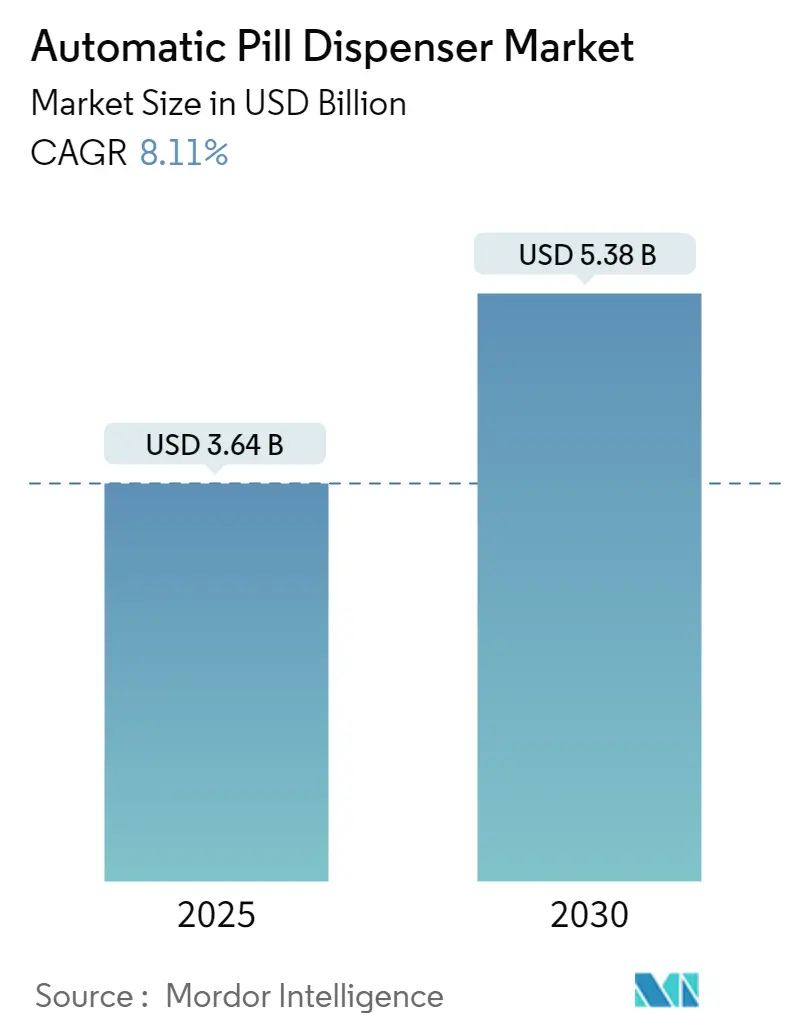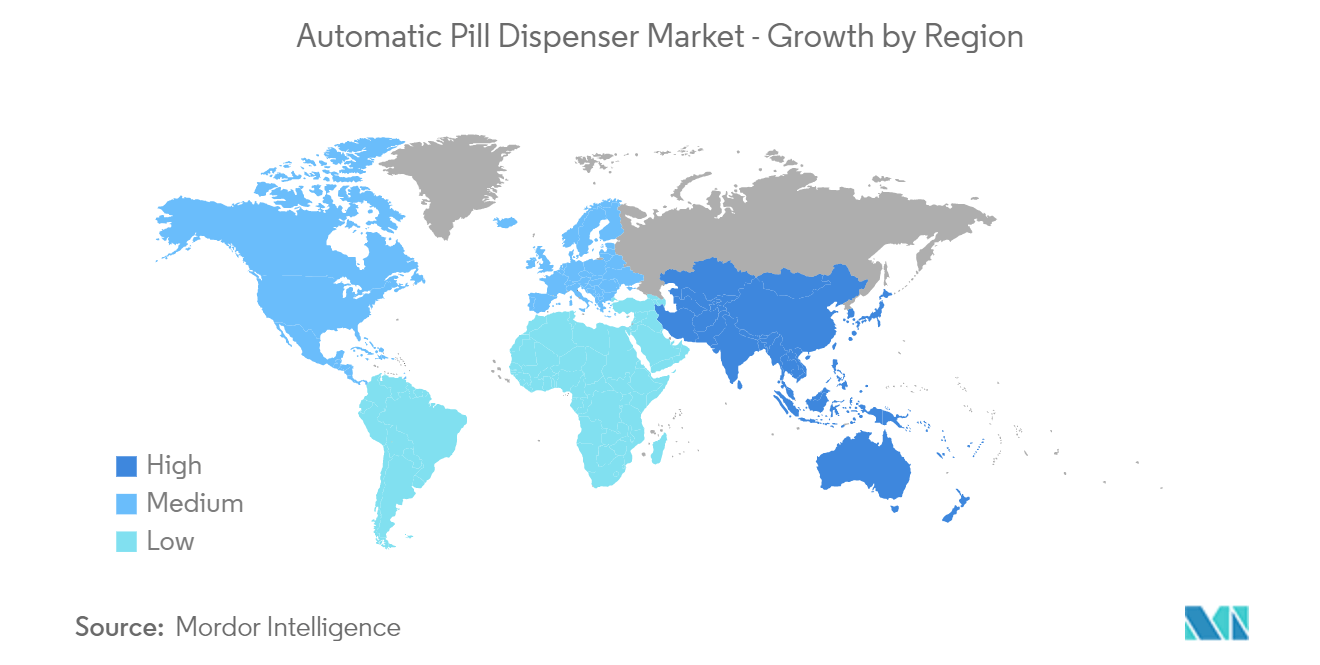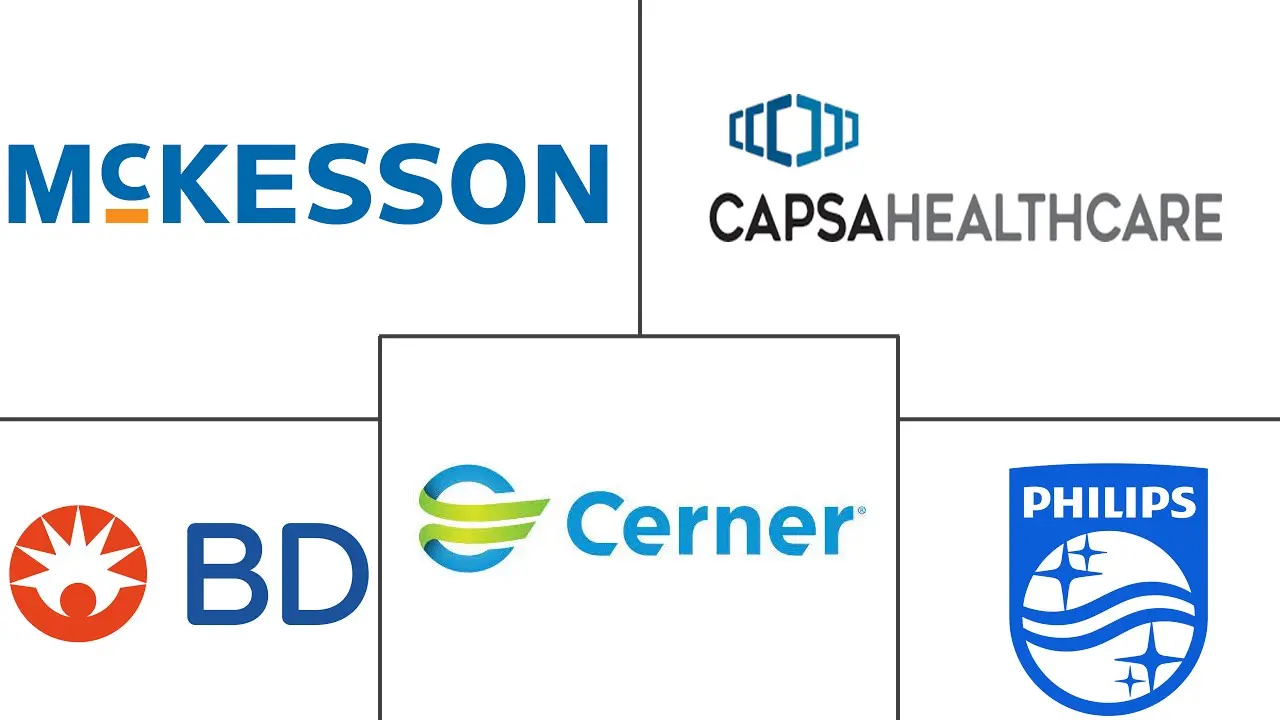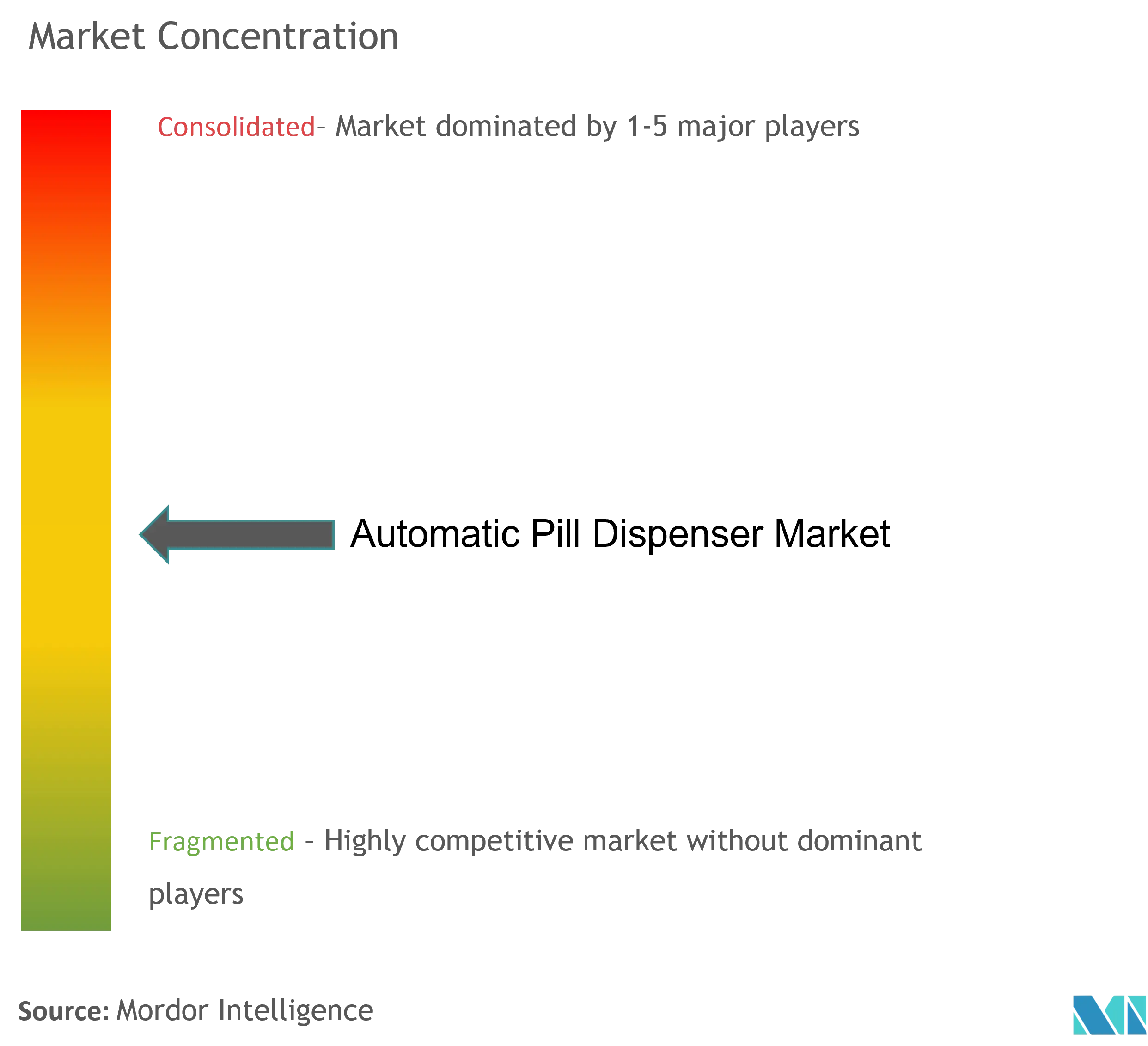
Automatic Pill Dispenser Market Analysis
The Automatic Pill Dispenser Market size is estimated at USD 3.64 billion in 2025, and is expected to reach USD 5.38 billion by 2030, at a CAGR of 8.11% during the forecast period (2025-2030).
COVID-19 led to a significant impact on the use of automated pill dispensers. The rising need for less human interaction boosted the demand for the product. For instance, according to the study published in the International Journal of Science Engineering and Technology, the major objective of the dispensing machine is to make medicine available to users around the clock so that it may assist villagers who live far from a hospital or clinic in purchasing medication. The increased workload in hospitals, the increased responsibility for patient satisfaction, and the effective dispensing time for single medications have a positive impact on the growth of the global automatic pill dispenser market in the forthcoming years. Furthermore, the market has seen a significant surge post-pandemic due to the rising importance of automated pill dispensers and rising awareness about medication adherence in the elderly as an automated pill system is a simple wearable gadget to set up and can dispense tablets to elderly post-covid patients who need assistance taking their medications.
The studied market growth is predominantly contributed by factors such as the growing burden of diseases, technological advancements in healthcare, and the increasing elderly population across the globe. Due to the changing lifestyle pattern, diseases are increasing largely among the population. For instance, 2021 WHO Global Health Estimates 2021 reported the top ten global causes of Disability-Adjusted Life Years (DALYs) were neonatal conditions, ischaemic heart disease, stroke, lower respiratory infections, diarrhoeal diseases, road injury, chronic obstructive pulmonary disease, diabetes mellitus, tuberculosis, and congenital anomalies. Also, there has been the greatest increase in death in females around threefold due to dementia and Alzheimer’s over the past two decades, with around 80% more deaths and 70% more DALYs in females than males due to these neurological diseases.
With the increasing cases of Alzheimer's and dementia, there are increased chances of missing doses of medication or wrong administration of it, hence increasing the need for an automatic pill dispenser. For another instance, in 2022 Alzheimer's Association reported that more than 6 million Americans lived with Alzheimer's, and this number is expected to increase by 13 million by 2050. Alzheimer's is a chronic disorder associated with depression, memory loss, and other physiological issues in the geriatric population, thereby increasing the patient's visits to hospitals; thus, concerning the above-mentioned facts, the automatic pill dispenser market is expected to show lucrative growth over the forecast period.
The elderly population is increasing across the world and is largely affected by some kind of chronic disease. With increasing age, forgetfulness becomes very common in geriatric people, so it becomes a challenge to keep on track with the medications. Moreover, the United Nations, Department of Economic and Social Affairs (UNDESA), World Population Ageing Highlights, 2022 stated that in 2022, there were 771 million people in the world aged 65 or over and which is projected to be 994 million in 2030 and 1.6 billion by 2050. Thus, the increasing aging is leading to an increased burden of chronic diseases all over the globe, and the need for care drives the automatic pill dispenser market.
Moreover, the other factors associated with the growth of the automatic pill dispenser market, like technological adoptions in healthcare, also participate in the growth. However, the cost associated with automatic pill dispensers may hamper the growth of the market.
Automatic Pill Dispenser Market Trends
Decentralized Automatic Pill Dispenser Segment is Expected to Hold Significant Market Share Over the Forecast Period.
The automatic pill dispenser cabinets are used in hospitals and hospital-pharmacy to optimize medication management with patient care and pharmacy performance to provide improved and focused care. These cabinets manage the user’s access to the medication and also store information according to the individual’s permission, and track the transactions made. Also, the cabinets occupy smaller floor space, thus making larger space available in hospitals for other purposes.
Decentralized automatic pill dispersers are medication management systems that allow hospitals to store and dispense drugs near the point of use. In the nursing ward or nursing unit, decentralized automatic pill dispensers store and electronically administer medications. These devices provide nurses with ready access to medications while maintaining tight control of drug distribution, enabling the quick, on-demand provision of drugs for the patients and nurses.
The rising benefits of the decentralized automatic pill dispensers are anticipated to drive segment growth. For instance, according to the study published in Cures Journal in August 2022, medicine dispensing by the nurse on the ward is made simpler by decentralized automatic pill disperser systems, which also enhance medicine storage until the patient needs it. As a result, it is less likely that prescription errors will occur, drugs will be used more effectively, and nurses and chemists will spend less time overall. Therefore, there is effective management of medication dispensing with less chance of medication errors through the decentralized automatic pill disperser, thereby anticipated to drive the segment growth.
The decentralized automatic unit dose dispensing system can be used in hospitals and pharmacies to reduce the time in dispensing or inpatient care or home care centers for unit-dose dispensing. According to the Automated Pill Dispenser Article, Theseniorlist, July 2021, about 7000 to 9000 people die every year in the United States due to medication errors, including wrong medication, improper dosage, and missing the round of it. Therefore, medication errors increase the demand for automatic unit dose dispensing to provide accurate drug delivery, driving segment growth.
Rising strategies from the market players, such as mergers, acquisitions, and partnerships, are again driving the market segment. For instance, in December 2021, PharmAdva, the manufacturer of comprehensive medication management and real-time data solution called MedaCube, entered a collaboration with Mayo Clinic, which enhanced its advanced care at home program that offers hospital-level care at home. The MedaCube is a fully automated, bulk-loaded, personal pill dispenser that safely stores, tracks, and dispenses scheduled or as-needed medications to patients.
Thus, with the rise in patient awareness of health conditions and the adoption of technologically intelligent solutions for improved patient care, the decentralized automatic pill dispenser is expected to show significant growth over the forecast period.

North America Holds a Significant Share in Market and Expected to Grow in the Forecast Period.
The North American region holds a significant share of the automatic pill dispenser market and is expected to show the same trend in the forecast period. The factors driving the market in the regions are the wide acceptance of technologically advanced solutions to make patient care hassle-free, a large pool of customers, a rapidly growing geriatric population, and a strong foothold of major market players.
Technological advances in the region due to the key market players are another reason for driving this market segment. For instance, in December 2021, Hero and AdhereHealth entered a strategic partnership. Hero's platform includes a connected smart pill dispenser, which automatically sorts and dispenses medications according to a patient's unique medication schedule. This partnership has led to simultaneously improving patient safety by focusing on medication management, further supporting caregivers, and helping people take more control of their health. In addition, in March 2022, Assure Health and Hero entered a partnership to enhance healthcare for seniors. The collaboration combines Hero's medication management platform, which enhances drug adherence and keeps patients on track with their therapy regimens, with Assure Health's Remote Therapeutic Monitoring ("RTM"), which digitally monitors and delivers care to patients. The program will be made available by Assure Health to qualified Medicare beneficiaries. Therefore, these partnerships further propel the market growth due to the increased adoption of automatic pill dispensers in remote settings.
The increasing incidence of the geriatric population in the region is also contributing to the growth of the market in the region. For instance, in 2022 United States Census Bureau reported that the number of Americans aged 65 and older will likely more than double over the next 40 years, reaching 80 million in 2040. Thus, the growing geriatric population is associated with a high prevalence of chronic diseases, thereby increasing the number of patients being admitted to hospitals and raising pressure on the traditional pharmaceutical system, thereby augmenting the industry value in the country.
Thus, the increasing pool of patients and prevalence of chronic and infectious diseases in North America makes it a preferable market for industry players and is expected to drive the market over the forecast period.

Automatic Pill Dispenser Industry Overview
The automatic pill dispenser market is a moderately competitive market with several players across the globe. The factors for the competition include the increasing burden of chronic and lifestyle diseases, growth in the elderly population, rising government initiatives, and rising initiatives from the key market players such as partnerships and launches, among others. Some of the key players in the market are Becton Dickinson and Company, Capsa Healthcare, Cerner Corporation, Mckesson Corporation, Omnicell, ScriptPro LLC, Swisslog Healthcare, Yuyama Co Ltd., Koninklijke Philips N.V., Hero Health, Inc, Pharmacell Medications Systems Ltd, and Medminder Systems, Inc.
Automatic Pill Dispenser Market Leaders
-
Becton, Dickinson and Company
-
Capsa Healthcare
-
Cerner Corporation
-
Koninklijke Philips N.V.
-
Mckesson Corporation
- *Disclaimer: Major Players sorted in no particular order
Automatic Pill Dispenser Market News
- May 2023: InventHelp inventor developed a smart automatic pill dispenser that controlled the dispensing of medication at specific times and dates. The design of the dispenser makes it easier for the patient to manage and keep track of their pill intake to better adhere to the requirements of the medication schedule.
- February 2023: At Rajiv Gandhi Government General Hospital, India, a new automated drug dispensing device was installed for the distribution of medications to patients registered under the non-communicable disease program. On a trial basis, the machine will likely distribute medication for illnesses like diabetes and hypertension.
Automatic Pill Dispenser Industry Segmentation
As per the scope of the report, the automatic pill dispenser is an advanced, high-tech solution that helps the patient with medication management and adherence. The automated pill dispenser can be portable or non-portable, allowing one to organize medicines according to the scheduled time. These devices ensure the dispensing of the correct pills via reminder alarms. Dispensing cabinets are used in hospitals and healthcare settings. These can be centralized or decentralized automated pill dispenser systems. The decentralized systems can be used at the point of care units in resident care units other than pharmacies.
The automatic pill dispenser market is segmented by type (centralized automatic dispensers (carousels and robotics) and decentralized automatic dispenser systems (ward-based automated dispenser systems, pharmacy-based automated dispenser systems, and automated unit dose dispenser systems), indications (physical disability, neurodegenerative disorders, dementia, and other indications), end users (hospitals, pharmacies, and home healthcare), and geography (North America, Europe, Asia-Pacific, the Middle East, Africa, and South America). The report also covers the estimated market sizes and trends for 17 countries across major regions globally.
The report offers the value (in USD) for the above segments.
| By Type | Centralized Automatic Dispenser | Carousels | |
| Robotic | |||
| Decentralized Automatic Dispenser | Ward Based Automated Dispensing System | ||
| Pharmacy Based Automated Dispensing System | |||
| Automatic Unit Dose Dispensing System | |||
| By Indication | Physical Disability | ||
| Neurodegenerative Disorders and Dementia | |||
| Other Indications | |||
| By End-User | Hospitals | ||
| Pharmacy | |||
| Home Healthcare | |||
| Geography | North America | United States | |
| Canada | |||
| Mexico | |||
| Europe | Germany | ||
| United Kingdom | |||
| France | |||
| Italy | |||
| Spain | |||
| Rest of Europe | |||
| Asia-Pacific | China | ||
| Japan | |||
| India | |||
| Australia | |||
| South Korea | |||
| Rest of Asia-Pacific | |||
| Middle East and Africa | GCC | ||
| South Africa | |||
| Rest of Middle East and Africa | |||
| South America | Brazil | ||
| Argentina | |||
| Rest of South America | |||
Automatic Pill Dispenser Market Research FAQs
How big is the Automatic Pill Dispenser Market?
The Automatic Pill Dispenser Market size is expected to reach USD 3.64 billion in 2025 and grow at a CAGR of 8.11% to reach USD 5.38 billion by 2030.
What is the current Automatic Pill Dispenser Market size?
In 2025, the Automatic Pill Dispenser Market size is expected to reach USD 3.64 billion.
Who are the key players in Automatic Pill Dispenser Market?
Becton, Dickinson and Company, Capsa Healthcare, Cerner Corporation, Koninklijke Philips N.V. and Mckesson Corporation are the major companies operating in the Automatic Pill Dispenser Market.
Which is the fastest growing region in Automatic Pill Dispenser Market?
Asia-Pacific is estimated to grow at the highest CAGR over the forecast period (2025-2030).
Which region has the biggest share in Automatic Pill Dispenser Market?
In 2025, the North America accounts for the largest market share in Automatic Pill Dispenser Market.
What years does this Automatic Pill Dispenser Market cover, and what was the market size in 2024?
In 2024, the Automatic Pill Dispenser Market size was estimated at USD 3.34 billion. The report covers the Automatic Pill Dispenser Market historical market size for years: 2019, 2020, 2021, 2022, 2023 and 2024. The report also forecasts the Automatic Pill Dispenser Market size for years: 2025, 2026, 2027, 2028, 2029 and 2030.
Our Best Selling Reports
Automatic Pill Dispenser Industry Report
Statistics for the 2025 Automatic Pill Dispenser market share, size and revenue growth rate, created by Mordor Intelligence™ Industry Reports. Automatic Pill Dispenser analysis includes a market forecast outlook for 2025 to 2030 and historical overview. Get a sample of this industry analysis as a free report PDF download.




